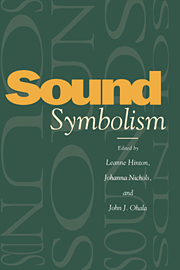Book contents
- Frontmatter
- Contents
- List of contributors
- 1 Introduction: Sound-symbolic processes
- PART I Native American languages north of Mexico
- PART II Native languages of Latin America
- 5 Symbolism and change in the sound system of Huastec
- 6 Evidence for pervasive synesthetic sound symbolism in ethnozoological nomenclature
- 7 Noise words in Guaraní
- PART III Asia
- PART IV Australia and Africa
- PART V Europe
- PART VI English
- PART VII The biological bases of sound symbolism
- Index
6 - Evidence for pervasive synesthetic sound symbolism in ethnozoological nomenclature
Published online by Cambridge University Press: 04 August 2010
- Frontmatter
- Contents
- List of contributors
- 1 Introduction: Sound-symbolic processes
- PART I Native American languages north of Mexico
- PART II Native languages of Latin America
- 5 Symbolism and change in the sound system of Huastec
- 6 Evidence for pervasive synesthetic sound symbolism in ethnozoological nomenclature
- 7 Noise words in Guaraní
- PART III Asia
- PART IV Australia and Africa
- PART V Europe
- PART VI English
- PART VII The biological bases of sound symbolism
- Index
Summary
Nomina debent naturis rerum congruere.
St. Thomas Aquinas“In establishing a harmony between a thing and its name, we conform to a psychic habit as old as humanity.”
J. Vendryès (1925): 183Introduction
Sapir's important study of sound symbolism (Sapir 1929) marks the beginning of an interest in the natural association of sound and meaning for twentieth–century linguistics. Building on Sapir's work, a large literature has developed on the subject of what the great linguist called “the expressively symbolic character of sounds quite aside from what the words in which they occur mean in a referential sense” (1929: 225).
Most of the experiments that have been carried out on sound symbolism in the last half century have been designed so as to require subjects to match pairs of words from one language with denotatively or connotatively equivalent words in an unknown language. The pairs of words utilized in these studies have almost invariably been antonyms. In spite of a number of methodological criticisms (see especially Taylor 1963; Taylor and Taylor 1965, 1967), the great majority of these experiments demonstrate unambiguously that certain sensations (such as relative size, movement, shape, texture, color) are regularly associated with the acoustic quality of specific phonetic segments.
The sound-symbolism experiment outlined in the present chapter, drawing on lexical data from Huambisa (one of the major speech communities of the Jivaroan language family in north central Peru) is in the tradition of word-matching studies, but differs from earlier experiments in that it deals not with antonymic pairs but with a large portion of zoological vocabulary.
- Type
- Chapter
- Information
- Sound Symbolism , pp. 76 - 93Publisher: Cambridge University PressPrint publication year: 1995
- 11
- Cited by



